Why Does the Government Continue to Change the Design of Paper Money
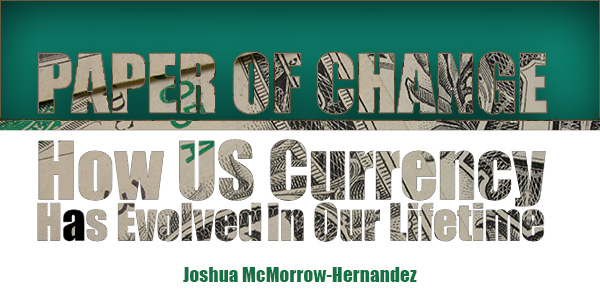
By Joshua McMorrow-Hernandez for CoinWeek.com …..
Take a look at the paper currency you're carrying around and think back several years. You'll probably notice that today's money looks much different than it did just a handful of years ago.
In many cases, the changes have been significant and obvious – such as the colorful security enhancements made to the $100 bill.
Then there are the countless minor, often unnoticed changes, such as minute design enhancements aimed at deterring counterfeiters. The updating of signatures from the Treasurer of the United States and the Secretary of the Treasury–not to mention Series dates–often occur virtually unseen by the general public, catching the eyes of only astute collectors who look for such details.
If former Treasury Secretary Jack Lew has his way, the $5, $10, and $20 bills are about to undergo drastic design changes as the portraits of women are introduced onto these bills over the next several years. Whether or not this happens in the timeframe outlined in 2016 by Lew, it certainly wouldn't represent the first changes to our nation's paper currency.
American adults in their 30s, 40s, 50s and older have witnessed the nation's paper currency evolve during their lifetimes. Many of these changes have occurred in the past half-century, and several only in the past three decades. One of the most momentous occasions of the past 50 years was our nation's 200th birthday in 1976, when the United States celebrated its Bicentennial with a new $2 note that honors the signing of the Declaration of Independence. Here's a look at how our nation's paper currency has changed since 1976.
The 1970s
As the patriotic fireworks were blasting around the United States on July 4, 1976, our nation's paper currency consisted of seven bills ranging in denomination from $1 to $100. With the exception of the $2 bill, currency printed in 1976 belonged to Series 1974 and contains the signatures of Treasurer Francine Neff and Secretary of the Treasury William Simon.
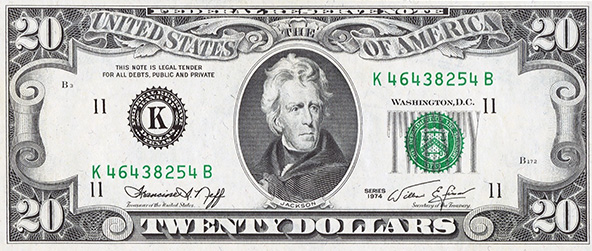
Meanwhile, the $2 Federal Reserve Note served as a Bicentennial commemorative issue. The bill, issued as Series 1976, contains on its reverse The Declaration of Independence (circa 1819), a famous John Trumball painting that depicts the 1776 signing of the nation's founding document.
In 1977, signatures on the more widely used $1, $5, $10, $20, $50, and $100 notes changed to reflect the appointment of Azie Taylor Morton to the role of Treasurer and Werner Michael Blumenthal as Secretary of the Treasury. Blumenthal resigned in August 1979 for a private sector role and was replaced by George William Miller, whose signature is seen on Series 1977-A currency.
New serial-number presses were introduced in 1977 that produced a font that looks slightly different than the previous font. The old presses were retired over the course of a few years, and the old-style font is seen as late as Series 1981 on the $20 bill.
The 1980s
There were relatively few changes to U.S. paper currency in the 1980s. No significant design modifications were made to the nation's currency during the decade, and sweeping security-related enhancements were still to come in the '90s. The only notable changes to the nation's paper currency in the '80s involved the periodic changing of the guard at the United States Treasury.
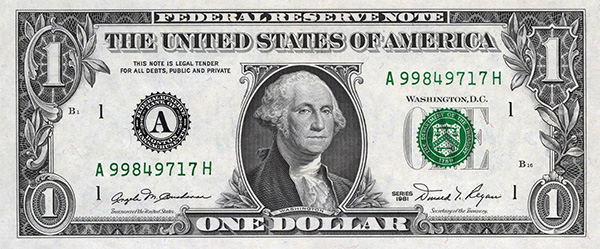
Series 1977 currency was produced into the early 1980s, when Angela Marie "Bay" Buchanan began serving as Treasurer under President Ronald Reagan in 1981. Buchanan, who at 32 became the youngest person appointed to her role, served as Treasurer until she was appointed Chairwoman of the President's Commission on Women Business Owners in 1983. Buchanan's signature is paired with that of Donald Thomas "Don" Regan, who was the Secretary of the Treasury from 1981 through 1985. The Buchanan-Regan signatures are seen together on Series 1981 notes.
After Buchanan left her role in 1983, Katherine D. Ortega was appointed as Treasurer. Her signature is paired with Regan's on Series 1981-A notes. Ortega remained in her role throughout the rest of President Reagan's two terms and also served under his successor, President George H.W. Bush. Ortega's name was subsequently seen paired on U.S. currency with two other Secretaries of the Treasury, including James Addison "Jim" Baker (on Series 1985 currency) and Nicholas Frederick Brady (Series 1988), the latter serving in that role under both Reagan and Bush.
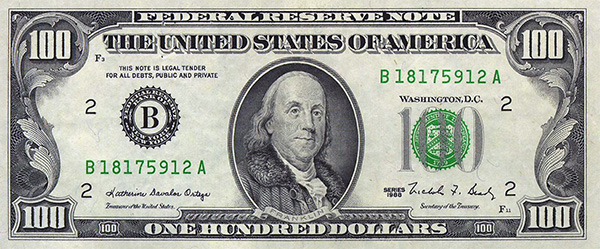
Ortega remained as Treasurer until July 1, 1989, when she returned to working in her family's accounting firm, as she had prior to serving the public. Her replacement was Catalina Vásquez Villalpando, who served as Treasurer for the remainder of Bush's single term as president, from December 11, 1989 until January 20, 1993. Her signature is paired with Brady's on Series 1988-A ($1, $5, $10, and $20) and Series 1990 ($10, $20, $50, and $100) Federal Reserve Notes. It should be noted that security threads and microprinting were introduced to help deter counterfeiting beginning with Series 1990 currency.
The 1990s
Series 1990 marks a major milestone for United States currency. After decades of relatively few changes to the nation's paper money, new anti-counterfeiting advances were being utilized. This was largely due to improved computer and printing technologies in the private sector, which allowed criminals to more readily produce highly deceptive counterfeit notes.
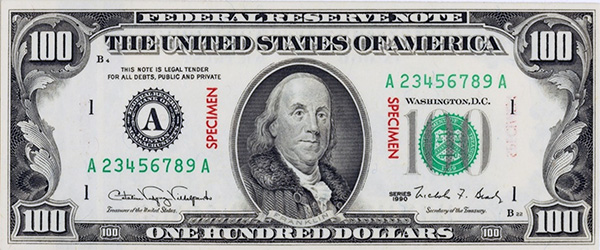
The first appearance of the modern-age, anti-counterfeiting changes came in 1990, when security threads and microprinting were unveiled on the $100 bill. The changes include a metallic security strip with the alternating numerals "100" and letters USA on the left side of the bill. The strip glows pink when viewed under ultraviolet light. Meanwhile, microscopic printing around the portrait of Founding Father Benjamin Franklin bears the phrase UNITED STATES OF AMERICA.
The next bill to receive these new changes was the $50 note. The new bill was unveiled in November 1991 with the same security enhancements as seen on the $100, including microprinting with the text "UNITED STATES OF AMERICA" around President Ulysses S. Grant's portrait. Regarding the new security features, the only differences between the new $50 and $100 notes concern the material and color of the embedded security strip and its text. The security thread on the $50 note is made from plastic and appears yellow under ultraviolet light. The strip is printed with the numerals "50", along with the letters "USA". Despite its release in 1991, the new $50 bill was issued as a Series 1990 note.
The new generation of security features was rolled out on the $20 bill in April 1992. Beginning with Series 1990, $20 bills feature microprinting with the phrase "UNITED STATES OF AMERICA" around the portrait of President Andrew Jackson. The embedded plastic security strip on the $20 bill glows green and includes the words "TWENTY" and "USA".
Printing of the new $10 notes began in July 1992. Requisite microprinting around the portrait of Secretary of the Treasury Alexander Hamilton is included on the $10 note, along with an embedded security thread that glows orange when illuminated by ultraviolet light and bears the text "TEN" and "USA".
Despite these sweeping changes on higher-denomination Federal Reserve Notes in the early 1990s, they were not the last security changes to be introduced to our nation's paper currency during the decade. Rapidly changing computer and printing technology aided counterfeiters, keeping officials at the United States Treasury and the Federal Reserve vigilant.
On March 25, 1996, the first major design changes to United States currency since 1929 took place on the $100 bill with the intent of further deterring counterfeiters. New and enhanced security features included optically variable ink that changes from green to black as it is viewed from different angles, a watermark of Franklin, and fine-line printing around his obverse portrait and the reverse image of Independence Hall. One of the most visible changes on the new Series 1996 $100 bill is a significantly enlarged, higher-quality portrait of Franklin.
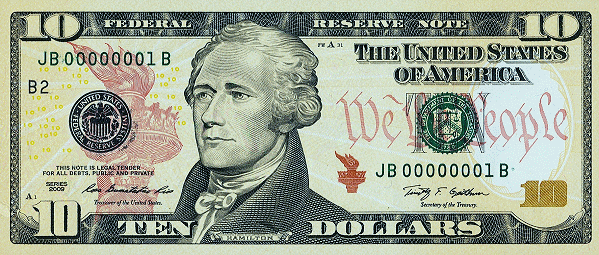
These enhancements did not replace the older security features but rather augmented their efficacy. However, the metallic thread first embedded on Series 1990 $100 bills was replaced with a plastic thread that glows red under ultraviolet light. Other security features left intact from previous generations include interwoven red and blue silk fibers that have appeared on U.S. currency since the 19th century.
Similar security enhancements worked their way down to the $50 bill in October 1997, the $20 bill in September 1998, and by 2000 had reached the $10 and $5 notes; a small flag was added on the security strips for each of these denominations except for the $100 bill. Meanwhile, this generation of $5 notes did not receive the color-shifting ink that appeared on higher bills of the era. However, all denominations affected by the security enhancements unrolled during the late 1990s ($5 through $100 bills) received a new, unified Federal Reserve System seal along with an additional prefix letter appearing at the beginning of the serial number on each bill.
The $1 and $2 notes, the latter issued as Series 1995, remained unchanged.
New Treasurer and Secretary of Treasury signatures were the most notable modifications seen on U.S. paper currency of the 1980s. However, news of the periodically changing John and Jane Hancocks seemed to get lost in the shuffle as more attention was paid to the sweeping design changes on our nation's currency throughout the '90s.
Mary Ellen Withrow served as Treasurer from 1994 through 2001, a period that took her through most of President Bill Clinton's first term and all of his second. Her signature appears on Series 1993, Series 1995, Series 1996, and Series 1999 Federal Reserve Notes. Meanwhile, Lloyd Miller Bentsen, Jr., was appointed by President Clinton as U.S. Treasury Secretary in 1993 and served in that role until retiring late 1994. His signature appears on Series 1993 notes.
Bentsen's successor was Robert Edward "Bob" Rubin, who served as Secretary of the Treasury from January 1995 until July 1999, and his signature appears on Series 1995 and Series 1996 notes. Following Rubin's departure, Lawrence Summers was appointed as Treasury Secretary from 1999 through 2001, and his signature is seen on Series 1999 bills.
The 2000s
With the intention of staying at least one step ahead of counterfeiters, the Feds introduced even further, more noticeable changes during the first decade of the 21st century. Unlike the previous convention of introducing enhanced security features first on the $100, the newest round of updates were first seen on the $20 bill, which is the most commonly used note aside from the $1 bill.
These security enhancements first appeared on October 9, 2003, when the Series 2004 $20 bill received a more colorful design with security upgrades. These new anti-counterfeiting measures include the addition of 90 faintly printed, yellowed-colored "20"s that are scattered on the reverse of the bill in a shape resembling the EURion Constellation, which roughly resembles the star constellation Orion within a pattern of five rings seen on Euro banknotes. This feature is designed to help deter photocopying and optical scanning; all major imaging and design software (such as Adobe Photoshop) will refuse to scan the note if such a trigger is found [This sometimes makes illustrating an article about paper money a tricky endeavor. —CoinWeek]. The ovals surrounding both the portrait of Jackson and the White House on the back were removed, subsequently requiring enhancements to those two designs. Shades of green and yellow were also added to the background of the $20 bill.
Next up were changes to the $50 bill, which came on September 28, 2004 and were issued under Series 2004. Revisions to the design of the $50 bill included the removal of borders around Grant's portrait and the Capitol Building as well as the first use of multiple colors on U.S. currency since the Series 1905 $20 Gold Certificate. These vibrant design enhancements include the addition of a red-and-blue colored image of a stylized American flag in the background of the obverse and a silver-blue flag to the right of Grant's shoulder. Tiny yellow "50"s in the EURion Constellation pattern seen on the new $20 bill also appear for the first time on the $50 reverse. Other security enhancements first implemented on Series 1996 $50 bills remained.
In 2006, the $10 bill was similarly splashed with color beginning with its issuance for Series 2004-A. The bill was themed with new red highlights, including red-colored background renderings of the Statue of Liberty's torch and, in a red-hued font, the phrase "We The People" from the United States Constitution (Hamilton was an ardent supporter of the Constitution who also signed the document). Also added were light-colored yellow and orange hues in the background of the bill. Among other changes were the removal of the borders around both Hamilton's portrait and the U.S. Treasury building on the reverse and the addition of numerous tiny yellow "10"s in a EURion Constellation pattern on the left side of the Hamilton portrait and to the right of the U.S. Treasury building.
The $5 bill was redesigned in 2007, with the new Series 2006 notes entering circulation in March 2008. The redesigned $5 bill has similar security-minded enhancements as seen on the newly re-crafted $10, $20, and $50 bills that had been released between 2004 and 2006. Borders were removed from both the portrait of Abraham Lincoln and the Lincoln Memorial. A large heraldic eagle with hues of violet and blue was added to the right Lincoln's profile on the obverse and is superimposed by several preexisting features, such as the phrase UNITED STATES OF AMERICA, the bill's serial number, and the Treasury seal. Numerous yellow "05"s are scattered on the left of Lincoln's portrait and on the right side of the reverse.
The $100 bill would receive numerous new enhancements consistent with those seen on lower-denomination bills since 2004, beginning in 2010. The $1 and $2 bills, meanwhile, would receive no new security improvements.
Amid all of these enhancements were several changes in the signatures borne on the evolving notes of the early 21st century. Series 2001 notes include the signatures of Treasurer Rosario Marin and Treasury Secretary Paul Henry O'Neill. In 2003, O'Neill, who disagreed with some aspects of President George W. Bush's economic and foreign policies, stepped down and was replaced by John William Snow, whose signature appears with Marin's on Series 2003 and Series 2004 ($20 and $50) bills.
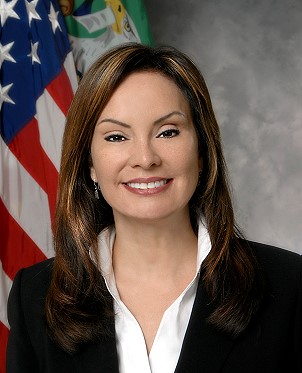
Marin, a Republican, resigned from her post on June 30, 2003 to make an ultimately unsuccessful run in California's 2004 Senate race. Replacing Marin in her former role as Treasurer was Anna Escobedo Cabral. Her signature shares obverse billing with Snow on Series 2003-A and Series 2004-A notes, the latter including revised versions of the $10, $20, and $50 bills. The signatures of Cabral and Secretary of the Treasury Henry Merritt "Hank" Paulson, Jr., appear together on Series 2006 and Series 2006-A $100 Federal Reserve Notes.
A new pair of signatures was introduced on Series 2009 notes upon the senatorial confirmations of Treasurer Rosa Gumataotao Rios and Treasury Secretary Timothy Franz "Tim" Geithner. Both were tapped by President Barack Obama early in his first term.
The 2010s
More changes to the $100 bill were announced on April 21, 2010 and were first seen on new bills that entered circulation more than three years later, on October 8, 2013.
A number of revisions were made, including the addition of a brown-colored quill representing the one used to sign the Declaration of Independence and the image of an inkwell that appears and disappears as it is viewed from different angles. The new $100 bill also boasts a slightly retooled image of Franklin, whose portrait no longer is bound within an oval border. A teal background adds more color to the bill and visually coordinates with a 3-D security ribbon that contains miniature pictures of the Liberty Bell that transform into the numerals "100" as it the bill is viewed at different angles.
Numerous tiny, yellow-colored "100"s are scattered about the left side of Franklin in the EURion constellation and near the top of the note's reverse. The reverse vignette of Independence Hall was also modified, and the border formerly surrounding the view of the Philadelphia landmark was removed. To the right of Independence Hall is a sideways-facing numeral "100" in large, orange-colored font, replacing the smaller "100"s that used to occupy the upper right and lower right corners of the bill's reverse. The new $100 bills were first issued under Series 2009-A bearing the signatures of Rios and Geithner.
As of May 2017, U.S. currency is being issued under Series 2013, which includes the signatures of Rios, who served as Treasurer until July 8, 2016, and Treasury Secretary Jacob Joseph "Jack" Lew, who was nominated by Obama and confirmed by the Senate on January 25, 2013. Lew made headlines in 2016 when he negotiated with a grassroots feminist organization known as Women on 20s by agreeing to make several changes to the $5, $10, and $20 bills that include new designs featuring prominent women prominent for their efforts in the suffrage and Civil Rights arenas.
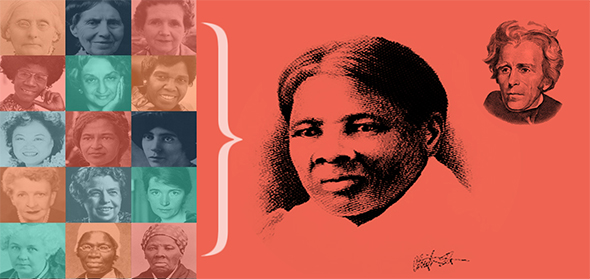
The original objective of the Women on 20s movement was to replace the portrait of Andrew Jackson on the obverse of the $20 bill with a design incorporating a pioneering female figure. The specific goal of replacing Jackson on the $20 bill was twofold; one aim was for a female to appear on the $20 bill in 2020, a year that marks the centennial of the 19th Amendment that gave women the right to vote in the United States.
The secondary goal of removing Jackson in favor of a woman would, in the viewpoint of Women on 20s supporters, right a "wrong" in honoring Jackson, who was a slaveholder and spearheaded an 1830s policy that forcibly removed Native Americans from lands in the southeastern United States. The "Indian Removal Policy" forced the migration of more than 100,000 Choctaw, Cherokee, Creek, Chickasaw, and Seminole peoples to areas west of the Mississippi River, causing thousands to die of exposure, disease and other maladies. This dark and deadly event in American history, which Jackson helped coordinate, is widely known as the The Trail of Tears.
The effort to remove Jackson from the $20 bill initially received wide support from millions of Americans across party lines. Meanwhile, Women on 20s initiated an online poll to help select what woman would appear on the face of the $20 bill. Choices included First Lady Eleanor Roosevelt, Civil Rights activist Rosa Parks and Cherokee Chief Wilma Mankiller. However, slavery abolitionist Harriet Tubman received the largest share of some 600,000 votes in May 2015. Lew soon responded to the massively popular viral campaign by announcing a woman's portrait would replace Alexander Hamilton's on the $10 by the year 2020.
Then Lin-Manuel Miranda happened.

Hamilton , a musical that debuted on Broadway in August 2015, quickly achieved critical acclaim and enjoyed widespread popularity. Subsequently, popular interest in the historical figure of Alexander Hamilton increased to heights unseen in generations–as well as a personal plea from Miranda–persuaded Lew to rethink his decision of removing the portrait of the Founding Father and nation's first Secretary of the Treasury. In April 2016, Lew announced that Hamilton would stay on the obverse of the $10 bill and Tubman would bump Jackson from the front of the $20 to the back of the bill. Lew also said changes were coming to the $5 and $10 that include the addition of reverse murals depicting prominent women who fought for civil rights.
The plan is to unveil the new designs for the $5, $10, and $20 bills in 2020 and issue the redesigned bills throughout the 2020s. However, the presidency of Donald Trump may have created a previously unforeseen wrinkle in these plans. President Trump, who openly admires Jackson (even restoring his portrait to the Oval Office) and has publicly expressed disdain for the current proposal to redesign U.S. currency with portraits of women, could theoretically issue an order to halt the currency redesign plan Lew announced in 2016.
As Women on 20s founder Barbara Ortiz Howard and those who support the cause wait to see whether or not Lew's plans are thwarted before 2020, other changes are in the works for currency over the coming years. These include the issuance of notes under a new Series presumably to include the signatures of new Treasurer Jovita Carranza and Treasury Secretary Steven Mnuchin. Carranza, whose Treasury role does not require Senate confirmation, was appointed by Trump on April 28, 2017. Meanwhile, Mnuchin was nominated by Trump and received Senate confirmation on February 13.
In addition to a pair of new signatures appearing on U.S. currency in the foreseeable future, other enhancements slated to come over the next few years include new anti-counterfeiting features. The details of these new security enhancements are, understandably, unannounced at this point. However, they are sure to incorporate some of the world's most recent anti-counterfeiting advances and help protect the integrity of U.S. paper currency for years to come.
Certified Small-Size Federal Reserve Notes Currently Available on eBay
[wpebayads]
Source: https://coinweek.com/paper-money-2/paper-currency-changed-lifetimes/
0 Response to "Why Does the Government Continue to Change the Design of Paper Money"
Post a Comment